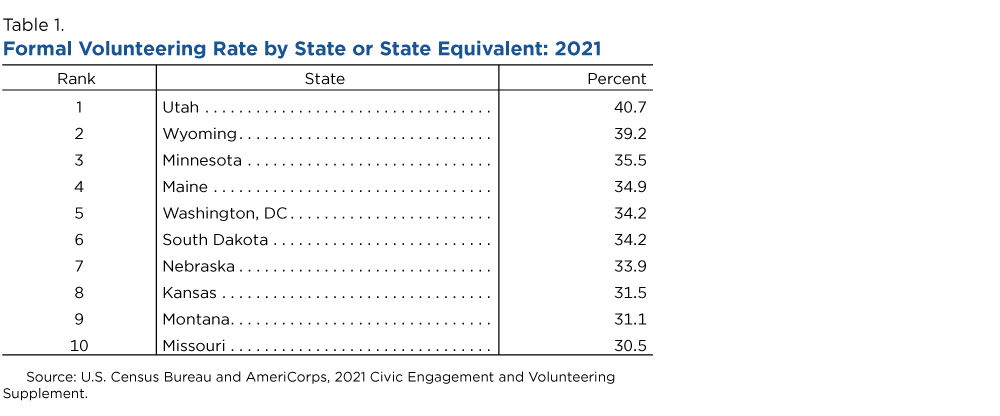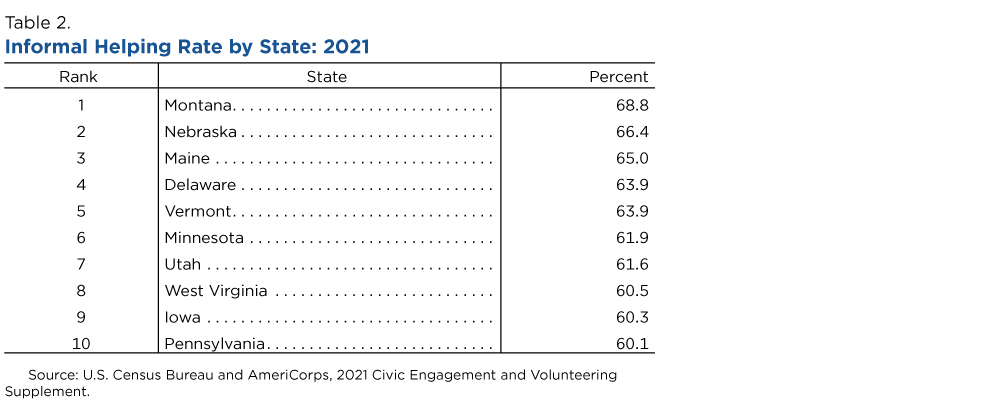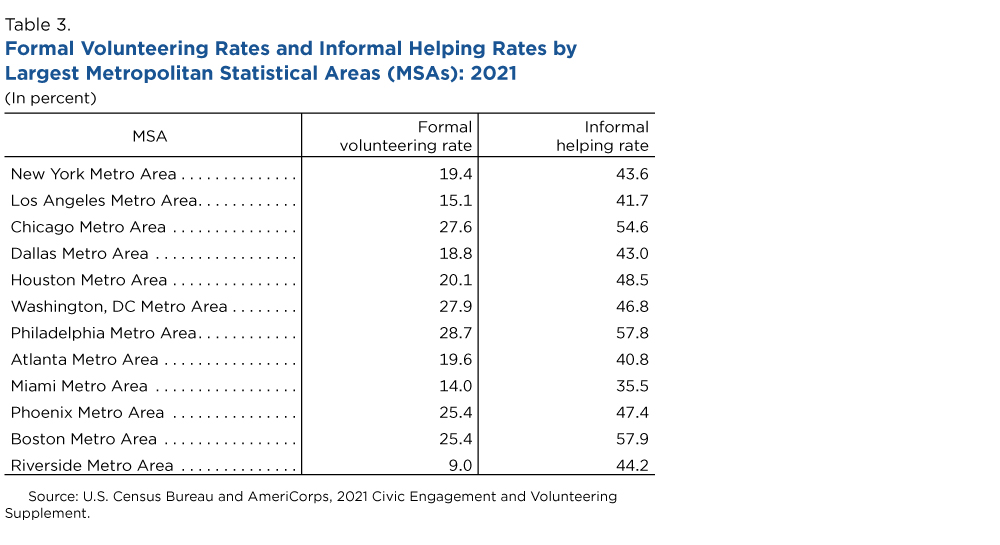
INDIANA – Nearly 51% of the U.S. population aged 16 and over, or 124.7 million people, informally helped their neighbors between September 2020 and 2021 at the height of the pandemic, according to the latest Volunteering and Civic Life in America research released Wednesday.
In response to a separate question, more than 23% of people in that age group, or 60.7 million, said they formally volunteered through an organization during the same period.

Indiana Highlights
- 1,462,479 formal volunteers contributed 89.2 million hours of service through organizations worth an estimated $2.4 billion
- 27.6% of residents formally volunteered through organizations
- 98.7% of residents talked to or spent time with friends or family
- 52.2% of residents informally helped others by exchanging favors with their neighbors
- 71.7% of residents had a conversation or spent time with their neighbors
- 29.4% of residents belonged to an organization
- 52.2% of residents donated $25 or more to charity
Conducted by the U.S. Census Bureau and AmeriCorps, the 2021 data show trends in formal volunteering, informal helping, and other civic behaviors nationally, at the state level, and within the 12 largest metro areas.
The research reveals that despite the devastating impact of the COVID-19 pandemic, the U.S. population continued to serve each other and their communities — giving their time and talent to help others at a time of unprecedented need.
The research, released every two years, shows that those who formally volunteered gave more than 4.1 billion hours of service with an estimated economic value of $122.9 billion.
The 2021 Civic Engagement and Volunteering Supplement released Wednesday are the most comprehensive data on U.S. volunteering and civic engagement assembled.
The research reveals that despite the devastating impact of the COVID-19 pandemic, the U.S. population continued to serve each other and their communities — giving their time and talent to help others at a time of unprecedented need.
They helped neighbors by doing favors like watching each other’s children, running errands, and other activities to lend a hand.
People also found new ways to help their communities during the pandemic by supporting COVID-19 testing, immunization, and other public health efforts; conducting wellness checks on isolated seniors; supporting food banks; and providing virtual tutoring and mentoring to help students stay on track in school.
2021 Civic Engagement and Volunteering Supplement
The goal of the research sponsored by AmeriCorps is to collect information on the extent to which our nation’s communities are places where individuals are civically active.
A comprehensive view on national and state formal volunteering and informal helping rates research includes:
- A national look at both formal and informal volunteering and civic engagement.
- Snapshots of formal volunteering and informal helping rates by demographic groups.
- Highlights of all 50 states and the District of Columbia’s formal volunteering and informal helping rates.
- Formal volunteering and informal helping rates for the 12 largest metropolitan areas.
National Demographics
While formal volunteering rates dropped from 2019 to 2021 in every demographic group, informal helping rates largely remained steady.
Trends in formal volunteering 2019-2021:
- The rate drop was substantially larger for women (8 percentage points) than for men (5 percentage points) but women continued to volunteer at a higher rate.
- Generation X (ages 41 to 56 in 2021) had the highest rate of all generations.
- People ages 16-17 had the highest rate of all age groups at 28%, followed by people ages 45 to 54 at 27%.
- Parents with children under 18 formally volunteered at a higher rate (30%) than those without children in their household (21%).
How many helped informally:
- Baby boomers had the highest rate (59%) of all generations.
- Veterans helped their neighbors at a rate of 59%, 8 percentage points higher than nonveterans.
- People with children under age 18 helped at a higher rate (58%) than those without children in their households (49%).
Top States and Metro Areas for Volunteering and Civic Engagement
Utah (40.7%) and Wyoming (39.2%) topped the list of states with the highest formal volunteering rates in 2021 (Table 1).
Montana (68.8%) and Nebraska (66.4%) had the highest rates of informal helping, which includes helping others outside of an organizational context like doing favors for neighbors (Table 2).
Between the 12 largest metropolitan areas, Philadelphia had the highest rate of formal volunteering (28.7%) and Boston had the highest informal helping rates (57.9%) (Table 3).
Volunteering and Civic Engagement in America complements a large body of other AmeriCorps’ research demonstrating a substantial return on investment in national service for both the government and the communities served, such as improved employment outcomes and mental and physical health benefits for those who volunteer.
AmeriCorps will release additional analyses of Civic Engagement and Volunteering Supplement data in the coming months.
Information: Erin Schneider is the content manager in AmeriCorps’ Office of External Affairs and Tim J. Marshall is assistant survey director for the U.S. Census Bureau’s Current Population Survey.






